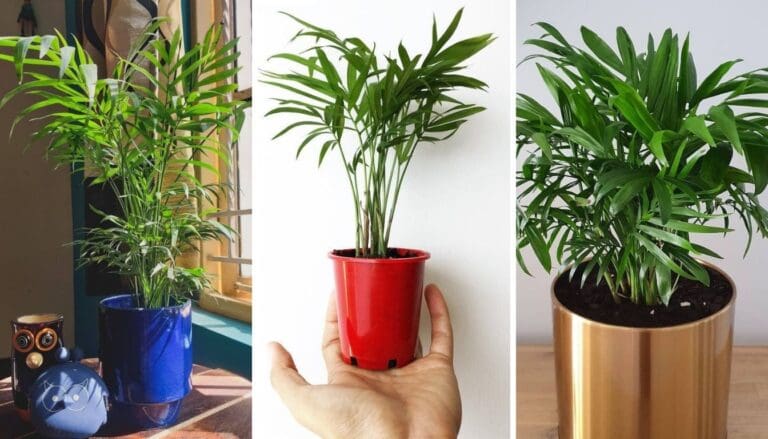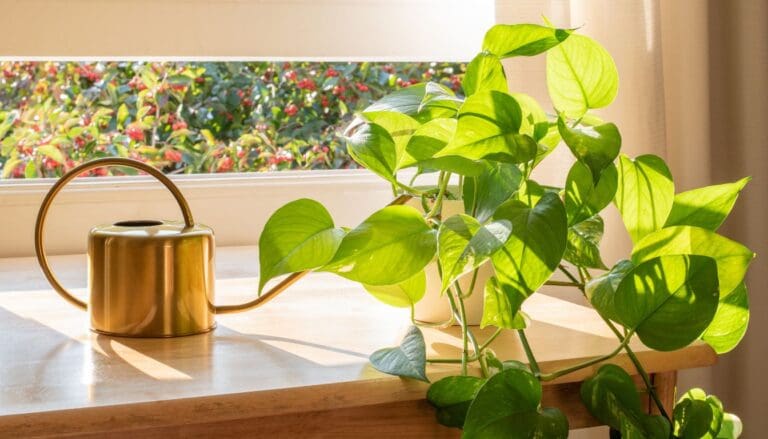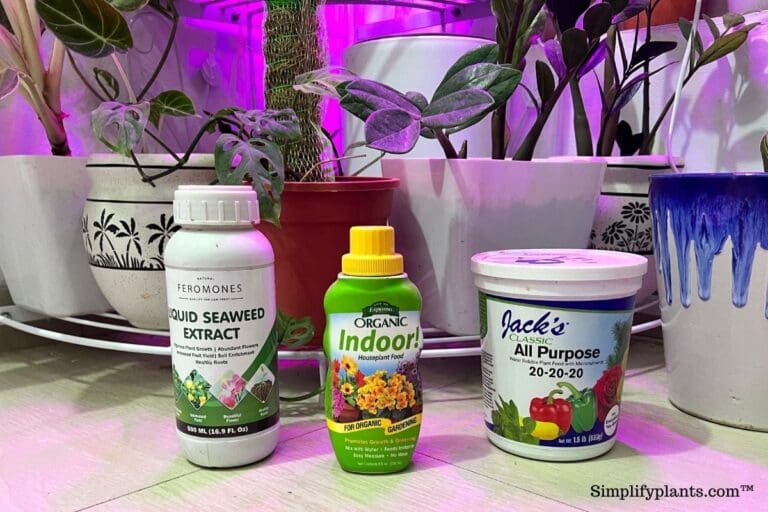Why Do Indoor Plants Get Holes In Leaves? (Causes+How To Fix)
A very annoying problem seen in all indoor plants is holes in the leaves. This not only gives your plant a lousy look, but this is a sign that your plant is going through some stress. If you don’t take proper steps, the plant might go through more problems.
But why do indoor plants get holes in leaves?
The primary reasons behind holes in the indoor plant leaves are pest infestations and diseases. Pests like aphids, mealybugs, spider mites, and diseases like leaf spots will create holes in your indoor plant leaves. Other causes are hot and dry air, low humidity, over-fertilization, and sunburn.
If your indoor plant leaves have holes, then you are at the right place. This article will help you understand and know all the reasons behind holes in the indoor plant leaves.
Understanding the causes will make it easier for you to deal with the issues and fix them.

Please note: Simplify Plants is reader-supported. Some links in the post are affiliate links and I get a commission from purchases made through links in the post.
Why are there holes in my indoor plant leaves?
If you notice occasional holes in some houseplants, your children or pets may have caused those accidental tears. Keep the indoor plants out of children’s or pets’ reach. Choose a place where no one comes in contact with them.
But if there are holes in all the leaves and it increases, the first thing that comes to mind is the bugs.
They not only attack the outdoor plants but even the indoor plants if the conditions are ideal. Indoor plants mostly get attacked by pests, mostly aphids, thrips, mealybugs, and spider mites.
If you have kept your indoor plants in an open area like a patio or window, the possibility is even the caterpillars and beetles will arrive and chew the leaves, creating holes in them.
Some diseases like leaf spot diseases are also the reasons behind holes in the houseplant leaves. Other than pests and diseases, other reasons can cause holes in the leaves: sunburn, high humidity, and over-fertilization.
Now let us discuss them in detail.
Pest infestation

Pests feed on the plants because they are hungry, and plants seem to be their best option. However, bugs don’t feed on all plants.
They choose specific plants for feeding. Aphids, mites, and mealybugs will like feeding on plants with tasty, sugary saps and no strong smells. But they won’t enjoy feeding on plants like mint, basil, or jade plants.
Pests don’t randomly choose your plant for their food. They infest your houseplant because they might have received the ideal conditions for their infestation. Some factors that encourage pest infestation are:
Low light: Pests love dark and damp places for their stay. If your indoor plants are kept in the dark areas or under low light conditions, they will get infected. And when you water your plant, the soil will remain damp.
If the plants are not receiving a good amount of light in such conditions, the pests will be happy to choose your plant for their living. Not only will they stay, but they will also even start breeding.
Overwatering: Another reason behind pest infestation is overwatering. When the soil becomes damp and soggy, the roots too start getting damaged.
The leaves turn yellow and progress to brown tips and edges. As a result, this creates an ideal condition for both pests and fungus to thrive.
High humidity: This is another factor that promotes pests. Accompanied with low light and overwatering, the plant’s condition will be made just perfect for the pests to feed and even start a family.
These three conditions together will not only harm the plant but can even kill it.
Pests that feed on the houseplants are:
Aphids: Small light green in color, aphids are found mostly underneath the leaves. They start with feeding on the sap of plants, progressing to chewing up the leaves. This also results in the plant’s stunted growth.
Mealybugs: They have a cottony look with fizzy bodies. They are found under the leaves. They, too, feed on the saps.
Spider mites: They look like small, tiny spiders. They are challenging to see with naked eyes. When you see holes along with fine web lines, you know that spider mites infest your plant.
Scales: They are black in color and round in shape. They nibble over the leaves and create holes by chewing the leaves.
Thrips: They are very tiny bugs found in indoor plants. They love to feed on the leaves and flowers too. They also suck out the sap, leaving the plant without nutrients altogether.
Other bugs that can eat up your plant are caterpillars, Japanese beetles, earwigs, sawfly larvae, flea beetles, and many more.
Even though some of these are outdoor pests, if your plant is kept near an open window or patio, they can also reach your plant and eat them up.
How to remove pests from indoor plants?
Some gardeners straightaway like treating the plant by using chemical pesticides and insecticides. But, before you do that, try some natural and organic ways of dealing with the plant. It will be chemical and toxic-free.
To get rid of pests from houseplants:
- First, isolate the plant immediately to stop the spreading of the pests to other plants.
- Shower your plant with some force to wash away all the bugs. Maintain an ideal pressure, ensuring not to harm them. Do this at least 3-4 times.
- If the colonies are pretty large, you might be able to see them. You can then handpick and remove them. Don’t forget to wear gloves.
- One practical and organic way to remove bugs is neem oil solution. Mix neem oil with water and spray it at the pest-infested areas and to the whole plant. As this is an organic spray, spraying all over the plant won’t harm them. Keep doing this for at least 2 weeks.
- Another solution is dish wash liquid soap. After applying, you must keep it for some time and rinse well.
- You should remove the leaves with the holes as they won’t become healthy again. Instead, pruning will help the plant focus on using energy to grow new leaves.
- If the infestation is severe and the organic method is not working, you can use chemical pesticides. Read the ingredients, the direction of use, warning, and caution carefully before using them. If possible, take the advice of some experienced people.
- You might also have to repot the plant in case if the soil has leftover eggs.
Diseases
Another common cause of holes in the houseplant leaves is the fungal disease. Not just the holes, fungal diseases can also give rise to other problems, like molds, mushrooms, etc., and eventually the death of the plant.
One common disease is leaf spot disease. This will first create brown ring spots with yellow haloes. As the disease progresses, the yellow haloes will disappear and form holes.
This happens when your plant doesn’t have enough ventilation and you have overwatered it. Slowly all the leaves will start getting affected.
How to get rid of diseases?
The leaves which already got affected by the diseases cannot be reversed. So, you will have to remove them to stop spreading the fungus to other parts of the plant.
The next important thing is isolating the plant to avoid the spreading of the disease. Now place a plant where it will get good airflow and bright light. These two will help to get rid of the fungus from your plant.
You will have to apply fungicide to your houseplant to treat them. You can use both organic and commercial fungicides. But first, try an organic one, and if it fails, you can go for the chemical ones. Be careful while applying the chemical fungicides.
For removing fungus, mix 2 teaspoons of baking soda and 1 drop of dish soap with 4 cups of water and spray this to your plant, especially the areas where the plant started the infection.
Sunburn

Most houseplants originate from tropical regions and will need warmth for thriving. But they will also not tolerate direct intense sun rays. When exposed to direct sun, they will get burnt and scorched.
Still, if you ignore the signs, the burnt leaves will become yellow and develop brown spots. This will progress, and the spots will form holes on the leaves.
How to fix it?
Relocate your plant by placing it in an area where it will receive bright indirect sun. Placing them near the north or east-facing window during the summer will work well. This direction supplies bright yet less intense sunlight.
During the winters, the intensity of the light reduces further. You can place your plant near a south or west-facing window.
If you have placed your plant in this direction during summers, I recommend you to pull down curtains or use Venetian blinds to create filters for the direct intense sun.
Lack of humidity
Some plants will not tolerate low humidity and will start developing holes. For example, pothos will only thrive in high humidity. Low humidity and a dry environment are not at all ideal for them. Especially the new leaves get affected.
Just like pothos, a lot of houseplants will need high humidity to survive. If they fail to receive good humidity, the leaves will turn crisp.
When this condition persists, the young emerging leaves stick to each other and don’t open out. They develop small holes, which is a sign of early damage.
How to fix it?
If your room has low humidity, install a humidifier. This device will mimic your houseplant’s exact humidity requirement, similar to its native land.
There are other methods, too, such as misting, pebble trays, group plantings, and terrarium jars. You can try anything according to your advantage.
Improper fertilizer

Too much fertilizer can increase salt build-up. It causes high salt concentration, which alters the natural pH level of the soil. This will lead to brown spots and even holes. This can also damage the tissues of your plant.
Sometimes, while sprinkling fertilizer, we make the mistake of spreading them on the leaves. This can burn the leaves, cause brown spots and sometimes holes in the leaves.
When some plants lack macronutrients such as nitrogen, phosphorous, and potassium or micronutrients such as iron or boron, leaf discoloration and distortion occur.
Yellow patches on the leaves progressing to pinholes are signs of potassium deficiency. Similarly, interveinal chlorosis progressing to elongated holes in old leaves is an indication of manganese deficiency.
How to fix it?
If you see no pests or diseases, you have not reduced humidity or exposed the plant to direct sun, and the houseplant leaves have holes, the reason might be fertilizers.
Try to recollect the last time you fertilized or remember the gapping in between fertilizing them.
If you have recently fertilized and found holes in your houseplant leaves, you may have sprinkled some on the leaves by mistake.
You might have fertilized too frequently, leading to salt build-ups due to which your plant leaves have holes.
Never apply fertilizer on the leaves. Always fertilize carefully, avoiding the leaves. Every plant will need fertilizing once a month or once in 2-3 months during its growing season. During the winters, most plants will not need fertilizing.
The best way to avoid over-fertilizing is by researching your plant’s fertilizing requirement, and then you can fertilize them the way they respond best.
If it is due to over-fertilization, stop fertilizing for some time. Get rid of the affected leaves. Take care of your plant. Once they start bouncing back to health, you can resume fertilizing.
Preventive measures
Once the leaves have holes, you can’t fix them. But you must take care of the plant. You will have to stop making the same mistakes as before to prevent the problems from happening again.
- Make sure your plant is receiving a good amount of light.
- Perform deep but infrequent watering. Keep checking the moisture of the soil. Sometimes, poor soil can also cause overwatering. In such a case, adding mulch can help in absorbing excess moisture.
- Provide them with exact humidity, neither high nor low. A humidifier can help in maintaining the perfect humidity. If, in any case, high humidity is creating the problem, reduce it.
- Do not ever keep your plant in damp conditions or deprive them of light. These two are the main reasons behind pest and fungus diseases. If ever you see any initial signs, treat them in the first place.
- You can mist your plants with neem oil once a month. This will help in preventing pests and fungus. If the infestation starts, the neem oil will suppress and prevent it from spreading by any chance.
Final words
Mostly pests and fungus are the reasons behind leaf holes. But some gardeners say these two are only possible when they are kept outdoors.
That is not entirely true. It will also happen indoors if conditions are made suitable for their infestation.
Do not give your plants a chance to create or cure holes. Follow the preventive measures properly. You can save your plant from developing holes in the leaves and keep them healthy.
If, by any chance, your plant has started showing holes, try to understand the reasons behind leaf holes and then treat them as per need.
Source: University of Illinois, Growing Indoor Plants with Success, Agriculture, and Natural Resources, University of California, Missouri Botanical Garden.
Recommended Garden Supplies
| Product Image | Our Recommended Gardening Supplies | Check Offers! |
|---|---|---|
Top Top
Top
Top
Top
Top
Top
Top
Top | rePotme Houseplant and Tropical Classic Potting Soil Mix | Check Offer On Amazon |
 Top
Top
Top
Top
Top
Top
Top
Top | Espoma Organic Indoor Plant Food | Check Offer On Amazon |
 Top
Top
Top
Top
Top
Top
Top
Top | GooingTop LED Grow Light 6000K Full Spectrum Clip Plant Growing Lamp | Check Offer On Amazon |
 Top
Top
Top
Top
Top
Top
Top
Top | Soil Moisture Meter | Check Offer On Amazon |
 Top
Top
Top
Top
Top
Top
Top
Top | Govee Hygrometer Thermometer, Bluetooth Enabled! | Check Offer On Amazon |
 Top
Top | LEVOIT Humidifiers for Large Room(Best For Plants) | Check Offer On Amazon |
 Top
Top
Top
Top
Top
Top
Top
Top | Upgraded DIY Automatic Drip Irrigation Kit, 15 Potted Houseplants Support | Check Offer On Amazon |
 Top
Top
Top
Top
Top
Top
Top
Top | Stainless Steel Heavy Duty Gardening Tool Set | Check Offer On Amazon |
 Top
Top
Top
Top
Top
Top
Top
Top | Bonide Insecticidal Soap | Check Offer On Amazon |
 Top
Top
Top
Top
Top
Top
Top
Top | Bonide 32 oz Spray Neem Oil for Organic Gardening | Check Offer On Amazon |
 Top
Top
Top
Top
Top
Top
Top
Top | Garden Safe Fungicide | Check Offer On Amazon |






